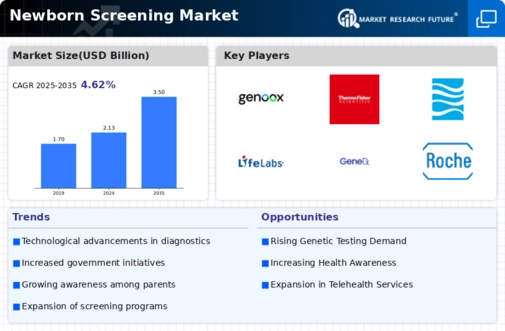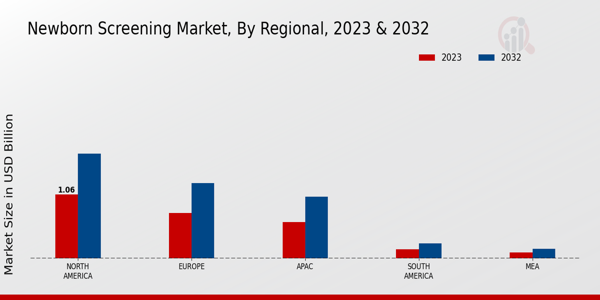Market Growth Projections
The Global Newborn Screening Market Industry is poised for substantial growth, with projections indicating a rise from 2.13 USD Billion in 2024 to 3.5 USD Billion by 2035. This growth trajectory suggests a compound annual growth rate of 4.62% from 2025 to 2035. Such figures reflect the increasing recognition of the importance of early detection of congenital disorders and the ongoing advancements in screening technologies. The market's expansion is likely to be fueled by a combination of government initiatives, technological innovations, and heightened awareness among healthcare providers and parents.
Government Initiatives and Policies
Government initiatives aimed at enhancing newborn health significantly influence the Global Newborn Screening Market Industry. Many countries have established mandatory screening programs to ensure early detection of metabolic and genetic disorders. For instance, the U.S. Department of Health and Human Services has set guidelines for newborn screening, which have been adopted by various states. Such policies not only promote public health but also encourage the development of advanced screening technologies. As governments continue to prioritize newborn health, the market is expected to expand, with projections indicating a growth to 3.5 USD Billion by 2035.
Rising Prevalence of Congenital Disorders
The increasing incidence of congenital disorders globally drives the Global Newborn Screening Market Industry. Statistics indicate that approximately 1 in 33 infants is born with a congenital anomaly, necessitating early detection and intervention. This trend emphasizes the importance of newborn screening programs, which can identify conditions such as phenylketonuria and cystic fibrosis. As healthcare systems recognize the need for early diagnosis, investments in screening technologies are likely to rise, contributing to the market's growth. The Global Newborn Screening Market is projected to reach 2.13 USD Billion in 2024, reflecting the urgency of addressing these health challenges.
Technological Advancements in Screening Methods
Technological innovations in screening methods are pivotal to the evolution of the Global Newborn Screening Market Industry. Advances in genetic testing, such as next-generation sequencing, enable the identification of a broader range of disorders with higher accuracy. These technologies facilitate faster turnaround times and reduce the need for invasive procedures. As healthcare providers increasingly adopt these advanced methodologies, the market is likely to experience significant growth. The anticipated compound annual growth rate of 4.62% from 2025 to 2035 underscores the potential for continued innovation and expansion within the industry.
Integration of Screening Programs into Routine Healthcare
The integration of newborn screening programs into routine healthcare practices is a significant driver of the Global Newborn Screening Market Industry. Many healthcare systems are now incorporating screening as a standard procedure shortly after birth, ensuring that all infants receive necessary evaluations. This systematic approach not only enhances early diagnosis but also fosters a culture of preventive healthcare. As more countries adopt similar practices, the market is expected to grow, reflecting a collective commitment to improving newborn health outcomes globally.
Increased Awareness Among Parents and Healthcare Providers
Growing awareness regarding the benefits of newborn screening among parents and healthcare providers plays a crucial role in shaping the Global Newborn Screening Market Industry. Educational campaigns and outreach programs have successfully highlighted the importance of early detection in preventing severe health issues. This heightened awareness leads to increased participation in screening programs, thereby driving market growth. As more parents understand the implications of congenital disorders, the demand for comprehensive screening services is likely to rise, further solidifying the market's trajectory in the coming years.






















Leave a Comment